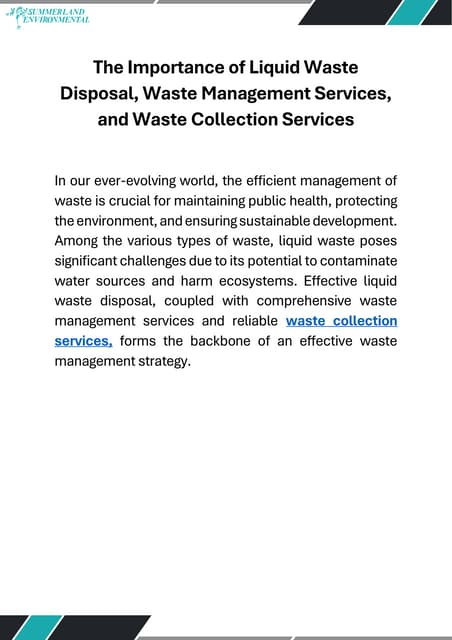Reclaim Waste Things To Know Before You Buy
Reclaim Waste Things To Know Before You Buy
Blog Article
Some Ideas on Reclaim Waste You Need To Know
Table of ContentsReclaim Waste - An Overview10 Easy Facts About Reclaim Waste DescribedThe 4-Minute Rule for Reclaim WasteWhat Does Reclaim Waste Do?Our Reclaim Waste Statements
Domestic sewage waste refers to the waste and items from a property septic storage tank. The appropriate management and disposal of residential sewage waste need liquid waste to be moved to a sewage treatment plant where the appropriate techniques and tools are used to detoxify and dispose of waste.
Industrial waste frequently consists of potential risks, such as combustible products or a mix of fluid and strong waste products, and needs an advanced and thorough disposal procedure. The disposal of commercial waste normally involves the filtering of waste prior to transport to make certain safe and appropriate disposal. Industrial waste is created from byproducts and overflow of industrial processes and manufacturing.
This sort of waste can not use the exact same sewage management transportation or processes as septic or industrial liquids. The industrial waste administration procedure needs the inspection and testing of liquid waste before it goes through the disposal procedure (liquid waste disposal). Runoff waste is the liquid waste that originates from runoff and excess stormwater in very booming locations or cities
Runoff waste can create contamination and flooding if not managed effectively. Ensuring correct waste administration can stop disasters and reduce ecological injury.
Reclaim Waste for Beginners
Contact PROS Services today to discover our waste management and disposal solutions and the proper methods to care for the liquid waste you generate.
(https://leonaube33101.wixsite.com/reclaim-waste/post/effective-liquid-waste-removal-and-disposal-everything-you-need-to-know)This so-called 'wastewater' is not just an essential resource but, after treatment, will certainly be released to our land, waterways or the sea. Utilized water from toilets, showers, bathrooms, kitchen sinks, laundries and industrial processes is recognized as wastewater.

water made use of to cool equipment or clean plant and equipment). Stormwater, a form of wastewater, is drainage that moves from agricultural and metropolitan locations such as roofings, parks, yards, roads, courses and gutters into stormwater drains pipes, after rain. Stormwater streams untreated directly to neighborhood creeks or rivers, eventually reaching the sea.
The Facts About Reclaim Waste Revealed
In Queensland, most wastewater is treated at sewer treatment plants. Wastewater is transported from domestic or commercial websites with a system of drains and pump terminals, recognized as sewage reticulation, to a sewage treatment plant.
The Department of Natural Resources advises city governments concerning handling, operating and preserving sewerage systems and therapy plants. In unsewered locations, regional governments might call for owners to set up individual More hints or household sewer therapy systems to treat residential wastewater from commodes, cooking areas, washrooms and washings. The Department of Natural Resources authorises using household systems when they are shown to be reliable.
In some new neighborhoods, therapy of some stormwater to remove litter, sand and gravel has begun using gross pollutant catches. Wastewater treatment occurs in four phases: Gets rid of strong issue.
Wastewater then streams into big tanks where solids clear up and are gotten rid of as sludge. Grease and residue are skimmed from the surface. Uses small living microorganisms understands as micro-organisms to damage down and remove staying liquified wastes and fine bits. Micro-organisms and wastes are included in the sludge. Removes nitrogen and phosphorus nutrients that might create algal blossoms in our waterways and endanger marine life.
The Definitive Guide to Reclaim Waste
Nutrient elimination is not available in all sewer therapy plants since it needs expensive specialist devices. It is ending up being extra usual in Queensland. Clear fluid effluent created after treatment may still consist of disease-causing micro-organisms. If this effluent is launched right into rivers such as rivers or the sea, the micro-organisms will at some point pass away out.

This typically suggests wastewater has actually to be dealt with or pollutants eliminated before it can be discharged to rivers. A lot of wastewater streams into the sewerage system. Under the Act, neighborhood federal governments carry out authorizations and licences for eco relevant tasks (Ages) including wastewater launches that could have a regional effect. The department carries out authorizations and licences to Ages involving wastewater launches that might have a local or statewide effect.
The Ultimate Guide To Reclaim Waste
Surveillance provides accurate information regarding water quality and can validate that licence conditions are being fulfilled. The details obtained through surveillance provides the basis for making water quality decisions.
Report this page